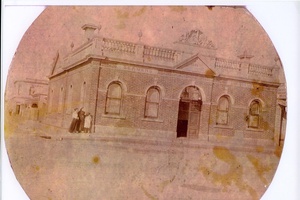-
Bay Street
The founding of Sandridge (which later changed its name to Port Melbourne) began one November day at the place where …
PMHPS
1 -
Port Melbourne Yacht Club
Liardet’s ti-tree jetty was replaced ten years later by the Town Pier, around which Sandridge grew. Over a century after …
PMHPS
0 -
Morleys Coal Depot
The depot stored coal from Newcastle that arrived at Town Pier to fuel the ships. Though not built until 1872, …
PMHPS
1 -
Liardet Memorial
The city’s 1988 Bicentenary contribution utilizing bluestone from demolished Harper factories.
PMHPS
0 -
Public Toilets
The two public toilets date from around the WW1 period. The multi-lingual signs, in English, Italian and Greek, were added …
PMHPS
1 -
Masckell McNab Memorial
The Maskell McNab Memorial that once stood near Graham railway station, is a tribute to two local railway men who …
PMHPS
0 -
The Anchorage
Across Beach Street is another eminent factory landmark, which in the 1990s became ‘The Anchorage’. Its unique residential spaces occupy …
PMHPS
0 -
St Josephs Hall and Church
On opposite corners are St. Joseph’s hall and church (unusual in that in 1857 this Romanesque style was rarely used …
PMHPS
0 -
Freemasons Tavern
The Freemasons tavern, later the Sandridge Hotel and now redeveloped, stood next to the original Freemasons Hall of the 1858 …
PMHPS
0 -
Tram Depot
Around the corner at Donaldson and Beach Streets was one of the eleven depots of Melbourne’s world renowned cable tram …
PMHPS
0 -
The original Seamens Institute building
The original Seamen’s Institute building is at Nott and Beach Streets. It replaced a small, timber bethel in 1888 and …
PMHPS
0 -
Post Office and Mail Exchange
Walking down Bay Street, near the corner of Rouse St, you will note the 1912 Naval Drill Hall next to …
PMHPS
0 -
Former National Bank
Like most buildings along Bay Street, many of those toward Graham Street date to the latter half of the 19th …
PMHPS
0 -
The colonial law and order complex
The colonial law and order complex at Graham Street now serves other purposes, the police station being legal offices and …
PMHPS
0

